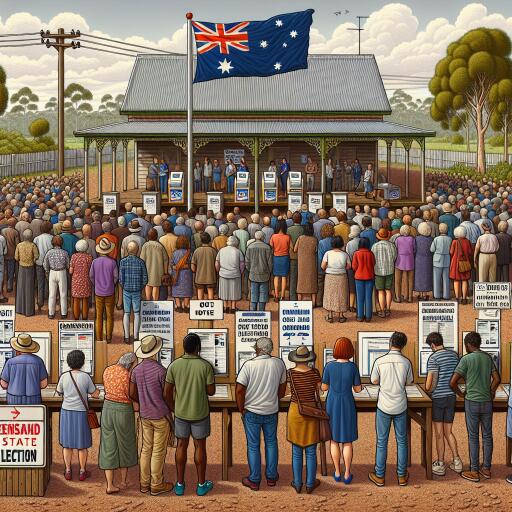
2024 Queensland State Election
The 2024 Queensland state election marks a critical moment for the region, drawing attention not solely due to the diversity of candidates and parties, but also because of the pressing issues within the political realm this year. Held on October 26, Queenslanders were tasked with electing members for the Legislative Assembly, thereby deciding which party will guide the state’s policies for the next term. This article delves into the election’s backdrop, discusses the leading concerns, highlights significant candidates and their positions, outlines the voting process, and summarizes the outcomes and implications.
Background and Context
This election occurs amidst profound economic and social shifts. Since the previous election, Queensland has confronted numerous challenges, ranging from economic variances to a housing crisis and an uptick in youth crime in regions such as Cairns and Townsville. These factors have increased scrutiny on governmental decisions. In response, major political parties have crafted platforms to address these urgent issues, presenting Queenslanders with differing visions for the state’s future.
The Queensland Legislative Assembly holds 93 seats, with at least 47 needed for a majority government. The Labor Party, under Premier Annastacia Palaszczuk, has governed for the last three terms, aiming for a fourth. Opposing them is the Liberal National Party (LNP), led by David Crisafulli, promising reforms targeting economic growth, enhanced law enforcement, and tackling social issues, especially for families and youth.
Key Issues in the Election
- Healthcare: The Labor Party asserts a strong focus on healthcare, pledging investments to expand hospital capacity, cut waiting times, and enhance mental health services. This continues Labor’s tradition of prioritizing social services. Meanwhile, the LNP addresses perceived inefficiencies, proposing increased healthcare accessibility, particularly in rural areas.
- Crime and Youth Justice: Crime, particularly youth crime, is pivotal, notably in northern cities like Townsville and Cairns. The LNP advocates for stricter law enforcement, including an 8 pm curfew for minors in high-crime zones. Labor, acknowledging crime challenges, emphasizes addressing poverty and lack of educational opportunities as root causes via social programs.
- Housing and Cost of Living: The housing crisis pressures families, with both major parties unveiling housing strategies. Labor aims to boost affordable housing through government-developer collaborations, while the LNP seeks to ease property development regulations to increase availability and cut costs. Both promise to combat rising utility expenses and inflation.
- Economic Growth and Employment: Job creation and economic growth are top priorities. Labor highlights infrastructure projects for job creation and improved transport. The LNP suggests tax relief for businesses and incentives for tourism and agriculture as keys to economic revival.
- Environment and Energy: Environmental issues feature prominently, with Labor advocating renewable energy projects and conservation, aiming for net-zero emissions by 2050. The LNP supports a balanced approach between sustainability and economic development, promoting responsible mining and resource management.
Major Parties and Candidates
Labor Party (Incumbent): Led by Premier Annastacia Palaszczuk, the Labor Party has focused on social welfare, healthcare, and infrastructure since 2015. Their campaign emphasizes healthcare and housing, portraying Labor as capable of managing social issues. Palaszczuk positions herself as a stable leader, contrasting with the LNP’s less feasible promises.
Liberal National Party (LNP): Headed by David Crisafulli, the LNP promises reforms in crime policy, increased law enforcement, tax cuts, and business growth deregulation. Crisafulli’s crime focus resonates with voters in northern regions frustrated by crime. The LNP critiques Labor’s fiscal policies as unsustainable.
Queensland Greens: The Greens gain traction in urban areas, emphasizing environmental protection, social equity, and climate action. While unlikely to form a government, they could affect outcomes, particularly in Brisbane, with progressive voters.
Other Minor Parties and Independents: Several minor parties and independents, including One Nation and Katter’s Australian Party, compete, focusing on regional and ideological issues, potentially swaying closely contested seats.
Voting and Electoral Process
The Electoral Commission of Queensland (ECQ) ensured diverse voting options. Early voting was from October 14 to 25, with postal voting available until November 5, provided ballots were completed by October 26. On election day, polling places operated from 8 am to 6 pm, requiring identification.
For those unable to vote in person, alternatives included telephone voting for eligible voters, and mobile polling in aged care facilities and remote areas. The ECQ’s varied options underscore a commitment to inclusive electoral participation, accommodating Queensland’s widespread population.
Election Outcomes and Projections
Early projections show a tight race in key regions, with marginal seats potentially determining the outcome. Rural areas and crime-impacted regions might lean towards the LNP, attributable to their law-and-order stance. Labor’s focus on healthcare and social policies resonates with urban voters concerned about living costs and housing availability.
In some districts, preferences from minor parties like the Greens and One Nation could be decisive. Progressive support for the Greens is notable in Brisbane, while One Nation and Katter’s Australian Party exert influence in rural areas. Preference dynamics are pivotal in shaping the Legislative Assembly’s composition.
Implications and Future Perspectives
The 2024 Queensland state election underscores the state’s diverse and evolving needs. Should Labor win another term, its policies on healthcare and social housing might expand. A Labor win could strengthen its influence in Australia’s political landscape.
An LNP victory might shift policies towards conservatism, focusing on law enforcement and economic deregulation. Crisafulli’s administration would likely enact significant reforms in crime policy and economic incentives, possibly revising environmental regulations for industry support. However, this could face resistance from environmental and social service advocates.
In conclusion, the 2024 Queensland state election reflects the intricate political landscape shaped by debates over healthcare, crime, housing, and environmental policies. As Queenslanders await the final results, these outcomes are anticipated to have profound implications for both state and national contexts, indicating whether the state’s future aligns with Labor’s progressive agenda or the LNP’s conservative approach. The state’s forthcoming years will see significant developments as the elected government tackles Queensland’s unique challenges and opportunities.





Leave a Reply